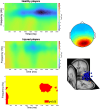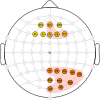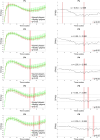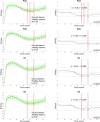Cortical changes associated with an anterior cruciate ligament injury may retrograde skilled kicking in football: preliminary EEG findings
- PMID: 39820802
- PMCID: PMC11739489
- DOI: 10.1038/s41598-025-86196-4
Cortical changes associated with an anterior cruciate ligament injury may retrograde skilled kicking in football: preliminary EEG findings
Abstract
Anterior cruciate ligament injuries (ACLi) impact football players substantially leading to performance declines and premature career endings. Emerging evidence suggests that ACLi should be viewed not merely as peripheral injuries but as complex conditions with neurophysiological aspects. The objective of the present study was to compare kicking performance and associated cortical activity between injured and healthy players. Ten reconstructed and 15 healthy players performed a kicking task. Kicking biomechanics were recorded using wearable inertial measurement unit sensors. Cortical activity was captured with a 64-electrode mobile electroencephalography. Multiscale entropy (MSE) analysis of biomechanics revealed increased variability in foot external rotation among injured players. Source-derived event-related spectral perturbations indicated significant differences in posterior alpha and frontal theta oscillations between the two groups. Furthermore, kick-related complexity of these regions as indexed by MSE was reduced in injured players at medium and coarse scales. Our findings suggest sensorimotor changes during kicking in injured players, which may necessitate compensatory strategies involving augmented attention at the cost of processing visuospatial information. This conflict may hinder the integration of task-relevant information across distributed networks. Our study provides preliminary insights into the neurophysiological implications of ACLi within football context and underscores the potential for prospective research.
Keywords: Anterior cruciate ligament injury; Electroencephalography; Football; Movement variability; Neurophysiology; Sports injuries.
© 2025. The Author(s).
Conflict of interest statement
Declarations. Competing interests: The authors declare no competing interests.
Figures







Similar articles
-
Behavioral and cortical dynamics underlying superior accuracy in short-distance passes.Behav Brain Res. 2024 Aug 5;471:115120. doi: 10.1016/j.bbr.2024.115120. Epub 2024 Jun 20. Behav Brain Res. 2024. PMID: 38905733
-
Three distinct mechanisms predominate in non-contact anterior cruciate ligament injuries in male professional football players: a systematic video analysis of 39 cases.Br J Sports Med. 2015 Nov;49(22):1452-60. doi: 10.1136/bjsports-2014-094573. Epub 2015 Apr 23. Br J Sports Med. 2015. PMID: 25907183 Free PMC article.
-
Factors associated with returning to football after anterior cruciate ligament reconstruction.Knee Surg Sports Traumatol Arthrosc. 2015 Sep;23(9):2514-21. doi: 10.1007/s00167-014-3023-4. Epub 2014 May 27. Knee Surg Sports Traumatol Arthrosc. 2015. PMID: 24861490
-
Prevention of non-contact anterior cruciate ligament injuries in soccer players. Part 1: Mechanisms of injury and underlying risk factors.Knee Surg Sports Traumatol Arthrosc. 2009 Jul;17(7):705-29. doi: 10.1007/s00167-009-0813-1. Epub 2009 May 19. Knee Surg Sports Traumatol Arthrosc. 2009. PMID: 19452139 Review.
-
Gender influences: the role of leg dominance in ACL injury among soccer players.Br J Sports Med. 2010 Aug;44(10):694-7. doi: 10.1136/bjsm.2008.051243. Epub 2010 Jun 11. Br J Sports Med. 2010. PMID: 20542974 Review.
Cited by
-
Advances in Research on Brain Structure and Activation Characteristics in Patients with Anterior Cruciate Ligament Reconstruction: A Systematic Review.Brain Sci. 2025 Aug 1;15(8):831. doi: 10.3390/brainsci15080831. Brain Sci. 2025. PMID: 40867163 Free PMC article. Review.
References
-
- Schiffner, E. et al. Anterior cruciate ligament ruptures in German elite soccer players: Epidemiology, mechanisms, and return to play. Knee25, 219–225 (2018). - PubMed
-
- Mai, H. T. et al. Performance-based outcomes after anterior cruciate ligament reconstruction in professional athletes differ between sports. Am. J. Sports Med.45, 2226–2232 (2017). - PubMed
Publication types
MeSH terms
LinkOut - more resources
Full Text Sources

